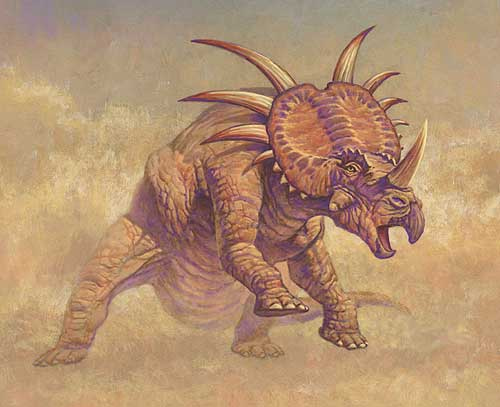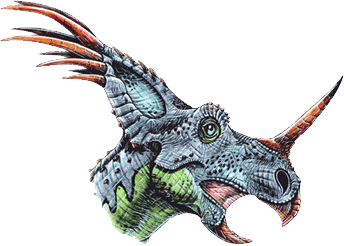Styracosaurus albertensis
Homepage > Dinosaur List S - Styracosaurus
albertensis
Dinosaur Lists by Letter A B
C D
E F
G H
I J
K L
M N
O P
Q R
S T
U V
W X
Y Z
(stih-RAK-uh-SAWR-us)
"spiked lizard"
Describer Lambe, 1913
Also Known As --
Type of Species albertensis
Order Ornisthischia
SubOrder Cerapoda
InfraOrder Ceratopsia
Micro-Order --
Family Ceratopsidae
Size 18 feet, (5.5 meters) in length
Period Late Cretaceous, 70 million years ago
Fossilsite Canada, US
Diet Quadrupedal Herbivore

Styracosaurus was a genus of herbivorous ceratopsian dinosaur from the Cretaceous Period, about 76.5 to 75.0 million years ago. It had four to six long horns extending from its neck frill, a smaller horn on each of its cheeks, and a single horn protruding from its nose, which was around 2 ft (0.6 meters) long and 6 in (0.15 meters) wide. The function or functions of the horns and frills have been the subject of debate for many years. For more on this subject click on the anatomy section on the navigation bar.
Styracosaurus was a large dinosaur, reaching lengths of 18 feet (5.5 meters) and weighing nearly 3 tons. It reached a height of about 6 feet (1.8 meters). Styracosaurus was a quadrupedal ceratopsian with short legs and a bulky body. Its body resembled that of a rhinoceros. Its tail was rather short. It also had a beak and flat cheek teeth, indicating that the animal was herbivorous. Like other ceratopsians, this dinosaur may have been a herd animal, traveling in large groups, as suggested by bonebeds.
Styracosaurus may have been a relatively fast dinosaur, perhaps running at up to 20 mph (32 kph). Paleontologists Gregory Paul and Per Christiansen of the Zoological Museum of the University of Copenhagen in Denmark proposed that large ceratopsians such as Styracosaurus were able to run at speeds exceeding that of an elephant, based on possible ceratopsian trackways.
 The
large nasal horns and frills of Styracosaurus are among the most distinctive
facial adornments of all dinosaurs. Their function has been the subject
of debate ever since the first horned dinosaurs were discovered.
The
large nasal horns and frills of Styracosaurus are among the most distinctive
facial adornments of all dinosaurs. Their function has been the subject
of debate ever since the first horned dinosaurs were discovered.
Early in the 20th century, paleontologist R. S. Lull presented the hypothesis that the frills of ceratopsian dinosaurs acted as anchor points for their jaw muscles. He later noted that for Styracosaurus, the spikes would have given it a formidable appearance.
In 1996, Dodson supported the idea of muscle attachments in part and created detailed diagrams of possible muscle attachments in the frills of Styracosaurus and Chasmosaurus, but did not subscribe to the idea that they completely filled in the fenestrae. C.A. Forster, however, found no evidence of large muscle attachments on the frill bones.
It was long believed ceratopsians like Styracosaurus used their frills and horns in defense against the large predatory dinosaurs of the time. Although pitting, holes, lesions, and other damage on ceratopsid skulls are often attributed to horn damage in combat, a 2006 study found no evidence for horn thrust injuries causing these forms of damage. Instead, non-pathological bone resorption, or unknown bone diseases, are suggested as causes.
The large frill on Styracosaurus and related genera also may have helped to increase body area to regulate body temperature, like the ears of the modern elephant. A similar theory has been proposed regarding the plates of Stegosaurus. This observation is highly suggestive of what is now believed to be the primary function, display.
The theory of frill use in sexual display was first proposed in 1961 by Davitashvili. This theory has gained increasing acceptance. Evidence that visual display was important, either in courtship or in other social behavior, can be seen in the fact that horned dinosaurs differ markedly in their adornments, making each species highly distinctive. Also, modern living creatures with such displays of horns and adornments use them in similar behavior.
Discovery
The first fossil remains of Styracosaurus were collected in Alberta, Canada
by C.M. Sternberg and named by Lawrence Lambe in 1913. This quarry was
revisited in 1935 by a Royal Ontario Museum crew who found the missing
lower jaws and most of the skeleton. These fossils indicate that S. albertensis
was around 5.5 to 5.8 meters in length and stood about 1.65 meters high
at the hips.
Barnum Brown and Erich Maren Schlaikjer collected a nearly complete articulated skeleton with a partial skull in 1915. These fossils were also found in the Dinosaur Park Formation, near Steveville, Alberta. Brown and Schlaikjer compared the finds, and, though they allowed that both specimens were from the same general locality and geological formation, they considered the specimen sufficiently distinct from the holotype to warrant erecting a new species, and described the fossils as Styracosaurus parksi, named in honor of William Parks.
In the summer of 2006, Darren Tanke of the Royal Tyrrell Museum of Palaeontology in Drumheller, Alberta relocated the long lost S. parksi site. Pieces of the skull, evidently abandoned by the 1915 crew, were found in the quarry.